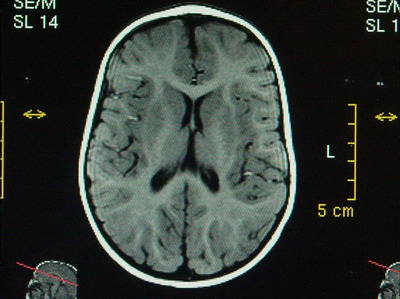|
| A case
Report
Congenital insensitivity to pain with anhidrosis (CIPA) or hereditary sensory and autonomic neuropathy type IV (HSAN IV) is a rare, autosomal-recessive sensory neuropathy, first reported by Nishida in 1951.[1] CIPA is caused by mutations in the
Neurotrophic tyrosine kinase, receptor, type 1
(NTRK1, TRKA) gene.[2] There does not seem to be a particular ethnic distribution for this recessive disorder but one half of reported cases have occurred in consanguineous marriages.[3] The cardinal feature of CIPA is absent or markedly decreased sweating causing episodic fevers and extreme hyperpyrexia which is usually the earliest sign of the disorder. Anhidrosis also contributes to the thick and calloused appearance of the skin with lichenification of palms, dystrophic nails, and areas of hypotrichosis on the scalp. [4] Emotional tearing is normal. The insensitivity to pain is profound and results in self-mutilation, auto-amputation, and corneal scarring. Fractures are slow to heal and large weight-bearing joints appear particularly susceptible to repeated trauma, and frequently go on to the development of Charcot joints and osteomyelitis.[5] The anomalous pain and temperature sensation is because of the absence of afferent neurones activation by tissue-damaging stimuli and the anhidrosis is the result of loss of innervation of exocrine sweat glands. [6] Oral manifestations can lead to its diagnosis. The typical and common feature
present in infantile patients with HSAN type IV is a decubital ulcer on the ventral surface of the tongue. They characteristically bite their tongue and fingers, apparently without pain, and their tongue, with normal fungiform papillae, patients always have a
bit or absent tip by the second year of life because of self-induced trauma. The rest of their childhood is marked by frequent accidental injuries resulting in significant morbidity. Lip wounds are noticed only on the lower lip, because the lower lip is more likely than the upper lip to be injured by self-mutilation. Multiple missing teeth because of autoextraction is a characteristic finding in more than one half of the subjects.[7] Neurologic studies such as electroencephalogram, cerebrospinal fluid, and sensory and motor nerve conduction studies are normal in the majority of patients.[8] Typical histologic findings include a complete absence of non-myelinated and small myelinated nerve fibers in the dorsal root ganglia and normal number and structure of the sweat glands, but lack of the innervations of small diameters neurons.[9]
Case report: A 15 months old female infant was referred by pediatricians to the Dermatology department of Assiut University Hospital, Egypt, presenting with multiple morphological abnormalities in the face, hands & feet. The patient was a product of uncomplicated pregnancy and delivery. Her parents were related by first degree consanguinity. they had five healthy siblings: 2 boys and 3 girls and had no family history of similar condition.
Clinical examination revealed (Fig. 1,
2):
- Bilateral corneal opacities.
- Irregular defect in the lower lip & the right side of tip of tongue.
- Missing teeth and dental caries.
- Erythematous scaly patches on face mainly forehead.
- Shortening of index finger of left hand with fusiform swelling at its end.
- Peeled erythematous skin of the fingers & toes.
- Impaired sensation on the extremities.
- Dystrophic toe nails.
- Oval ulcer on sole of left foot.
Laboratory investigations including serum uric acid were normal. Electroencephalogram and nerve conduction velocities were normal. Radiological bone survey was normal apart from absent distal phalanx and amputated middle one of the left index finger.
Normal audiogram but Tympanogram showed Eustachian tube dysfunction.
Magnetic resonance imaging of the brain
(Fig. 3) revealed changes of cortical brain atrophy at the frontoparietal region with normal corpus callosum.
2 months later the patient presented with:
- loss of both thumbs and shortening of the other fingers.
- Traumatic ulcers at the forehead and left eyebrow.
- Completely eroded lower lip and anterior half of tongue.
To the best of our knowledge, this is the first case of HSAN Type IV to be reported in Egypt, no similar cases has been found in their relatives. In addition to the classical features of the disease, magnetic resonance imaging of the brain
(Fig. 3) revealed changes of cortical brain atrophy at the frontoparietal region and tympanogram showed Eustachian tube dysfunction findings have not been reported in similar cases. References
1. Nishida G. Congenital Anhidrosis. Saishin Igaku (Japan) 6: 1100-1104, 1951.
2. Indo Y,
Tsuruta M, Hayashida Y, Karim MA, Ohta K, Kawano
T, Mitsubuchi H, Tonoki H, Awaya Y & Matsuda I. Mutations in the TRKA/ NGF receptor gene in patients with congenital insensitivity to pain with anhidrosis.
Nature Genetics 13, 485 - 488, 1996.
.
3. Oddoux C, Wang J, Clayton CM. Genetic heterogeneity in hereditary and autonomic sensory neuropathy (HSAN4). Society of Human Genetics, October, 1999.
4. Pinsky L, DiGeorge AM. Congenital familial sensory neuropathy with anhidrosis. J Pediatr 68:1-13, 1966.
5. Felicia B. and Max J. Inherited Autonomic Neuropathies. Seminars in Neurology 23 (4), 2003.
6. Indo Y. Genetics of congenital insensitivity to pain with anhidrosis (CIPA) or hereditary sensory and autonomic neuropathy type IV. Clinical, biological and molecular aspects of mutations in TRKA (NTRK1) gene encoding the receptor tyrosine kinase for nerve growth factor. Clin Auton Res; 12(Suppl. 1): I20-I32, 2002.
7. Amano A, Akiyama S, Ikeda M, Morisaki I. Oral manifestations of hereditary sensory and autonomic neuropathy type IV. Congenital insensitivity to pain with anhidrosis. Oral Surg Oral Med Oral Pathol Oral Radiol Endod; 86:425-31, 1998.
8. Edwards-Lee TA. Cornford ME, Yu K-T T. Congenital insensitivity to pain and anhidrosis with mitochondrial and axonal abnormalities. Pediatr Neurol; 17: 356-61, 1997.
9. Goebel HH, Veit S, Dyck PJ. Confirmation of virtual unmyelinated fiber absence in hereditary sensory neuropathy type IV. J Neuropathol Exp Neurol 39:670-675, 1980.
© 2007 Egyptian Dermatology Online Journal |



